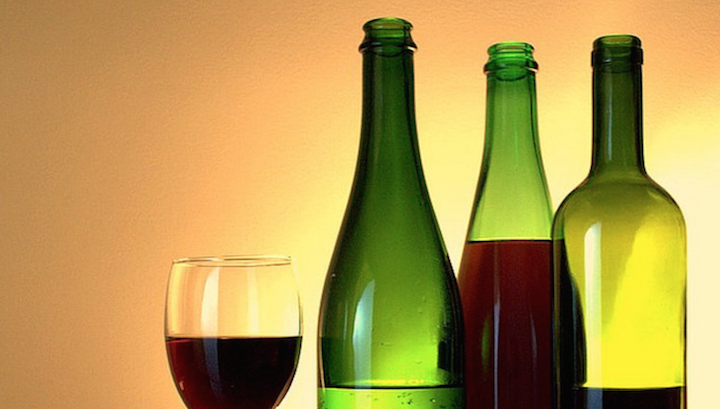
Beginning in 1953, The Ladies' Home Journal (a now defunct women's magazine) ran a column called "Can This Marriage Be Saved?" which featured details of issues faced by couples and advice for resolution or, at least, amelioration. Although a far less serious issue than marital strife, a common one faced by wine drinkers is "Can This Wine Be Saved?" and if so, what is the best method for preserving wine?
The Problem
For a variety of reasons, most wine drinkers at some point find themselves with a leftover open bottle of wine. Oxygen, at first, is the wine's best friend - enhancing its bouquet and softening the tannins as it "breathes" in the bottle (or is decanted) and is swirled in the glass. Thereafter, the Janus-faced oxygen becomes the wine's dread enemy, destroying or, at least, marring its remaining life. With prolonged exposure to oxygen, the wine will degrade. This degradation happens to both red and white wines. Initially, the wine loses its vibrancy and tastes flabby, flat or bitter; eventually, the wine turns into vinegar. (Technically, it turns into acetaldehyde which is sour but conversion to vinegar - aka acetic acid - generally requires acetic bacteria in a further chemical reaction).
Tick Tick Tick...
How long before that leftover wine becomes a potential salad dressing ingredient? Like most things about wine, it depends.
But there are a few known facts.
Unsurprisingly, sparkling wines lose their fizz very rapidly, go flat and then sour.
Wines with a lot of tannin, sugar or acidity (the aspects that make them long-lived and complex), such as Cabernet Sauvignon- and Nebbiolo-based wines or Rieslings and dessert wines, fare better over time than lighter, more fragile Pinot Noir-, Chardonnay- and Sangiovese-based wines.
Wines produced organically, biodynamically or sulfite-free are more sensitive than those with natural preservatives.
And one of the sad facts of age is that less is often more. To wit, older wines deteriorate more quickly than younger ones.
Leftover wine can, of course, be used for cooking in its pre-vinegar stage (or frozen for that purpose subsequently - do not even think of freezing it in a glass bottle) but with small effort, it can be enjoyed over the next day or two. And with a bit more effort, most wines may be enjoyed a few days or even a week later.
Advice for Resolution (or, at least, Amelioration)
Preserving Sparkling Wine
Sparkling wine poses unique storage issues because of its essential effervescence.
The single most important factor in saving sparkling wines is temperature. As many learned in chemistry class, temperature and pressure are directly proportional to each other (Gay-Lussac's Law). When temperature is lowered, the speed of gas molecules decreases which lowers the pressure. All chemical reactions proceed more slowly at colder temperatures.
The lower temperature and pressure make the carbon dioxide, which gives a sparkling wine its bubbles, more soluble. A cold sparkling wine retains the dissolved gas better than a warm one. The carbon dioxide not only produces the lovely bubbles in Champagne and other sparkling wines but also limits oxidation. Thus, the first step toward preserving carbonation and lengthening life is to keep sparklers chilled.
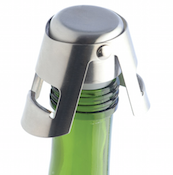 The other key step is to find a suitable stopper - most corks would pop out because of the remaining pressure. The homespun method of trying to halt the depressurization of bubbly by placing a teaspoon, handle down, into the bottle's mouth has been thoroughly debunked as futile in both amateur and scientific tests.
The other key step is to find a suitable stopper - most corks would pop out because of the remaining pressure. The homespun method of trying to halt the depressurization of bubbly by placing a teaspoon, handle down, into the bottle's mouth has been thoroughly debunked as futile in both amateur and scientific tests.
The best stopper to use for a sparkling wine is a flanged chrome one (pictured left) that plugs into the mouth of the bottle and is secured on either side by the flanged parts. This type is readily available and typically costs around $5.
Preserving Still Wine
Like sparkling wine, still wine also stays fresh longer if stored in a refrigerator. Gay-Lussac's Law again: the colder temperature inhibits oxidation and impedes the bacteria that convert the sugars to acid. If there is no room to store the wine in a refrigerator, find a cool, dark place away from sunlight.
In addition to keeping the wine chilled to slow down deterioration, there are four methods that help preserve the wine's drinkability; each involves minimizing the wine's exposure to oxygen.
Recork the Bottle - Perhaps the most obvious, recorking prevents more air from flowing into the bottle. Most people find inverting the cork (i.e., the wine-stained side up) easier when recorking because natural cork expands when pulled. But because the unstained side may have dirt, bacteria or mold that could contaminate the remaining wine, a better choice would be to recork it stained side down (which may require shaving the cork so it will fit) or to use a rubber or synthetic cork saved from another bottle.
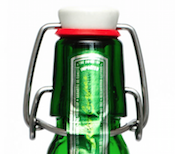 Rebottle the Wine - Less laborious than that sounds, simply decant the remaining wine into a smaller bottle (a steady hand or a funnel helps). In a smaller vessel, less of the wine's surface area is exposed to oxygen. Good candidates for this low-technology solution are empty half bottles, Mason jars and beer bottles that come with a hinged stopper e.g. the one used by the Dutch beer company, Grolsch (pictured right). Plastic bottles are not suitable.
Rebottle the Wine - Less laborious than that sounds, simply decant the remaining wine into a smaller bottle (a steady hand or a funnel helps). In a smaller vessel, less of the wine's surface area is exposed to oxygen. Good candidates for this low-technology solution are empty half bottles, Mason jars and beer bottles that come with a hinged stopper e.g. the one used by the Dutch beer company, Grolsch (pictured right). Plastic bottles are not suitable.
After rebottling, it is best to store the leftover wine upright. This minimizes the surface area exposed to oxygen and potential leakage.
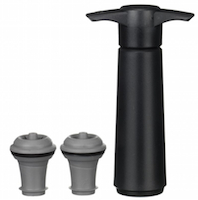 Pump out Excess Air - A vacuum device like the Vacu Vin Wine Saver (about $15 with two rubber stoppers, pictured left) is one way to extract the oxygen. One inserts the rubber stopper in the bottle's mouth and then pumps with the hand pump until one hears a clicking noise indicating that the oxygen has been dispelled and a vacuum has been created. The wine then is best stored upright in the refrigerator. The rubber stopper can be pulled or pushed from below to remove. The Vacu Vin generally extends the wine's life by three to five days. It is ill-suited for a sparkling wine for it would suck what little life is left of the wine from the bottle.
Pump out Excess Air - A vacuum device like the Vacu Vin Wine Saver (about $15 with two rubber stoppers, pictured left) is one way to extract the oxygen. One inserts the rubber stopper in the bottle's mouth and then pumps with the hand pump until one hears a clicking noise indicating that the oxygen has been dispelled and a vacuum has been created. The wine then is best stored upright in the refrigerator. The rubber stopper can be pulled or pushed from below to remove. The Vacu Vin generally extends the wine's life by three to five days. It is ill-suited for a sparkling wine for it would suck what little life is left of the wine from the bottle.
A variation of this process is the method used by the Air Cork Wine Preserver (about $29, pictured below) which was chosen by Cook's Illustrated as its favorite wine-saving device. It entails inserting a food-safe latex balloon into the bottle and inflating it above the wine's surface with a pump, thereby forcing out most of the air. 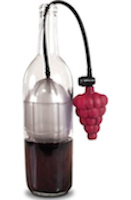 Wine preserved this way typically lasts about three days. Each balloon is guaranteed for 80 uses and replacements cost about $4. An obvious downside of this device is that it can only seal one bottle at a time. Some users complained that their balloons burst but indicated that the manufacturer readily sent replacements.
Wine preserved this way typically lasts about three days. Each balloon is guaranteed for 80 uses and replacements cost about $4. An obvious downside of this device is that it can only seal one bottle at a time. Some users complained that their balloons burst but indicated that the manufacturer readily sent replacements.
Add Inert Gas to Replace Oxygen - Inert gas is heavier than oxygen and therefore, if inserted into a wine bottle, it displaces the air and floats on top of wine protecting it from oxidation. Argon is usually the inert gas used because it is non-reactive and inhibits enzymes that enable oxidation.
One device to insert gas is the Private Preserve Inert Gas Aerosol (about $10) which is a mixture of nitrogen, carbon dioxide and argon gas. The original cork may be used to recork after spraying the gas into the bottle but a stopper with a latch would be more secure. Users report that a can typically lasts about 30 times (not the 120 times indicated on the label) but find it very difficult to assess how much is left in the can. In addition, users found degradation within a couple of days of use, perhaps because the gas is a mixture rather than totally inert.
 A considerably more expensive alternative is the Coravin system ($299, pictured left). Instead of pulling the cork, one inserts a 17-gauge, coated steel needle through the cork and presses a small button to draw the wine and replace argon in the remaining space. Then, one pours the wine through the integrated spout. Because cork is naturally elastic, the hole made by the needle closes. The Coravin manufacturer avers that wines can be kept for months this way. Although the Coravin system has many fans, many note that once they have consumed more than half of the wine, the wine begins to degrade quickly.
A considerably more expensive alternative is the Coravin system ($299, pictured left). Instead of pulling the cork, one inserts a 17-gauge, coated steel needle through the cork and presses a small button to draw the wine and replace argon in the remaining space. Then, one pours the wine through the integrated spout. Because cork is naturally elastic, the hole made by the needle closes. The Coravin manufacturer avers that wines can be kept for months this way. Although the Coravin system has many fans, many note that once they have consumed more than half of the wine, the wine begins to degrade quickly.
Early versions of the Coravin systems occasionally caused some bottles to shatter and those models were recalled. The current model minimized that danger and is sold with a neoprene sleeve to reduce any further risks. The Coravin system comes with two argon capsules. Each argon capsule only lasts for about five bottles and replacements are about $10 each. Also, a special needle is required for older wines (sold in a pack with a standard needle and a fast pour needle for about $69). Coravin does not work with decanters, screwtops or synthetic corks.
The Upshot
Refrigeration, rebottling and recorking, the low-technology solutions, are the most important steps to save remaining wine.
None of the devices to displace oxygen is a perfect solution but may expand the window of enjoyment of an open bottle of wine. The Vacu Vin is the least costly; those involving gas require replenishment of the gas containers.
These devices may help extend the life of the rest of the wine but polishing off a bottle of wine in one sitting is the only sure remedy!
For more information on the Coravin system, check out these Grape Collective articles:
Coravin Inventor Greg Lambrecht Talks Technology, Price, and Hermitage
Herons Sommelier Hai Tran Talks Coravin Trials, Barolo, and Bourbon
Wine, Romance, and The Coravin









